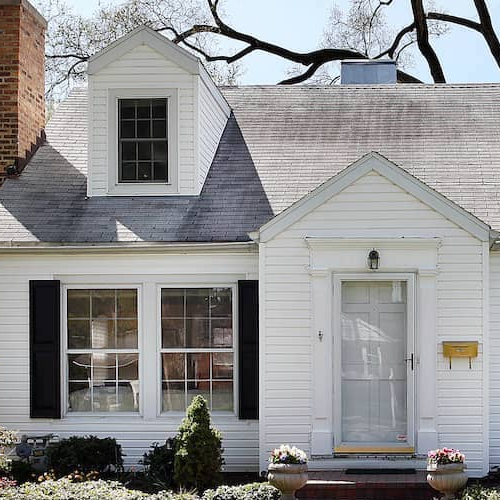How much is a tiny house?
Sep 23, 2024
•6-minute read
Tiny houses have been growing in popularity for years. Part of the minimalist lifestyle, the tiny house movement is a real estate trend based on simplifying your life by downsizing your living accommodations, which can ultimately lead to more financial freedom.
Tiny homes are a low-cost option for people in any stage of the homeowning journey. Some home buyers choose mobile tiny homes for convenient travel and easy relocation, while others choose them in order to downsize and live more sustainably.
But how much does a tiny house really cost? The average tiny home costs $45,000. However, the home’s size, type and level of customization will influence the final price. With tiny homes ranging in size from 100 – 400 square feet, you’ll need to consider several factors when calculating your potential costs.
How much does a tiny house cost on average?
The average nationwide cost of a tiny home is $300 – $400 per square foot compared to a traditional home’s $150 per square foot, making tiny homes typically cheaper to build or purchase. While the average cost of a tiny house is around $30,000 – $60,000, they can cost as little as $4,000 or as much as $180,000 depending on the amenities you choose.
It’s typically cheaper to build a tiny house than to buy one prebuilt, but don’t get too caught up in the savings. Consider the challenges of building a tiny home yourself. There’s always the risk that mistakes you make during construction could cost extra time and money to fix.
Beyond the decision to buy or build, other factors that will influence your overall cost include:
- The size of the house
- Whether you’re building on wheels or a foundation
- The building materials
- Building permit costs in your area
- Access to utilities
- The types of amenities you add
Because tiny homes are highly customizable, you’ll have more control over keeping costs low than you would when buying or building a traditional home.
How much does it cost to build a tiny house?
Although building a tiny house is generally the most affordable option, building the house yourself can require a significant upfront investment. If you decide to build your tiny house, it’s important to mentally, physically and financially prepare for the process.
The reality is that most tiny home builders spend anywhere between $14,500 – $60,000 or more depending on their preferences and the supply of building materials. Building permits average $1,380 nationally, although homes with larger floor plans and custom materials will raise that price.
Tiny houses on wheels tend to be cheaper as well. The foundation alone costs $4 – $7 per square foot, adding anywhere from $5,000 – $8,000 to the project’s price.
How much does it cost to buy a tiny house?
If building isn’t for you, you can purchase a prebuilt tiny home. You can find prefabricated tiny home providers across the country. Many of them even offer free shipping. While you can save significant time and effort when you buy rather than build a tiny house, it’s not uncommon for prebuilt tiny homes to end up costing $150,000 or more, especially after adding luxury features and finishes.
Buying a pre-owned tiny house could be a cheaper option. Pre-owned tiny homes typically cost less than brand-new tiny homes. However, when you buy pre-owned, you sacrifice the level of control you would have had over how your space is set up. Since tiny homes are often highly customizable, you should be able to tailor the space to your needs, but you’ll likely spend more money.
You can find tiny homes for sale in your area by searching local listings and national websites. Unlike traditional homes, most tiny homes don’t qualify for a traditional mortgage. Home buyers usually pay for a home with cash or they take out a personal loan.
Unforeseen costs of tiny homes
Buyers generally know to expect the obvious expenses, such as the costs of purchasing land and building materials, but there are some costs and building-related factors a buyer may not anticipate:
- Zoning laws: Depending on where you live, zoning laws may affect how your house gets built and where you can build it. For example, zoning regulations in your area may not allow putting your tiny house on a friend or family member’s land for free.
- Utilities: Your tiny home will require access to water and electricity. Depending on the location, you can hook up to local utilities. If your house is off-grid, you may need to install a septic system or renewable energy sources, like solar panels.
- Furniture and appliances: You may need to buy new furnishings if your full-sized items don’t fit in your tiny home.
- Storage: You may need to rent a storage unit if your belongings don’t fit your tiny home’s limited space. You can also donate or sell your oversized items.
- Home insurance: Getting tiny home insurance can be difficult and expensive.
- Resale value: Unlike traditional homes, tiny houses are not guaranteed to increase in value over time. In fact, tiny homes may depreciate, especially if they’re highly customized. And because tiny homes are a niche market, it can make them harder to resell.
How to finance your tiny home
From finding the right piece of land to building or buying your house, there are many steps involved in creating your ideal compact home.
1. Find the right land
If you’re building a tiny home on a permanent foundation the first step is to find and purchase land. Leasing land for a manufactured home is an easier option, but the value of the home will depreciate over time. Whenever you find a community you’re interested in, check what effect its zoning laws and regulations could have on building your home.
2. Take out a land loan
Not being able to purchase a tiny house with a traditional mortgage doesn’t mean there aren’t other financing options for tiny homes. One common alternative is a land loan. While Rocket Mortgage® doesn’t offer land loans, we do prioritize educating our clients on all their options.
Land loans are obtained the same way home buyers acquire a mortgage loan. However, it can be more challenging to determine the value of land with no property collateral than to determine the value of a house for sale with an assigned dollar amount. This makes land loans a higher risk for lenders, which typically results in larger down payments and higher interest rates compared to traditional home loans.
To qualify for a land loan, you’ll need to make a significant down payment and have a good credit score. Another key step is to create a solid, detailed plan describing how you want to develop the land. The plan will demonstrate to lenders your commitment to achieving your goal and paying off your loan.
3. Compare tiny house prices
Like most traditional houses, stick-built tiny homes are built on a foundation and are easily the most expensive. If you want to build a tiny home but don’t want to start from scratch, you can purchase a tiny house shell, which has a finished exterior and unfinished interior. Buying a shell can cut down on time and effort – but be careful. The more you customize the home with high-end features, the less affordable this option will become.
You can also purchase kit homes for less than $10,000. Kits include blueprints, a customized trailer to build on and a list of necessary supplies. Even with a kit, it’s best to only tackle building a tiny home if you have extensive construction experience.
Based on your budget, manufactured homes and modular homes are other types of tiny homes you may want to consider during your hunt for the right tiny house.
4. Fund your tiny house construction
If you’re building your tiny home, a construction loan can help you get started. A construction loan is a short-term loan that covers the costs of custom home building. Once the home is built, the borrower applies for a mortgage to pay for the completed home.
There are different types of construction loans. Deciding which loan is right for you will depend on the amount of financing you need and the specifics of the project you plan on executing. While Rocket Mortgage doesn’t offer most construction loans, current homeowners can opt for a cash-out refinance to access their home equity and fund the construction. Financing with a personal loan is another funding option tiny home buyers can explore.
The bottom line
Tiny homes aren’t for everyone. Despite their many benefits, tiny homes are challenging to build despite their smaller size. Before you downsize or opt for a simpler lifestyle, consider all the financial responsibilities of tiny homes to set yourself and your modest abode up for success.
Once you feel confident that you understand the difference between financing a traditional home and a tiny home, take action and start your mortgage application online with a Home Loan Expert at Rocket Mortgage.

Victoria Araj
Victoria is a former Team Leader of editorial content at Rocket Mortgage and she held roles in mortgage banking, public relations and more in her 19+ years with the company. She holds a bachelor’s degree in journalism with an emphasis in political science from Michigan State University, and a master’s degree in public administration from the University of Michigan.
Related resources
6-minute read
Modular vs. manufactured homes: What's the difference?
Modular and manufactured homes are both factory-built, but they have some key differences. Uncover the distinctions between modular and manufactured homes.
Read more

8-minute read
Is buying a house a good investment?
Is buying a house a good investment? It can be, depending on your personal circumstances. Before you buy, discover the pros and cons of purchasing a home.
Read more
6-minute read
Builder's risk insurance: What is it, what does it cover and should you get it?
Builder’s risk insurance protects properties under construction from damages. See whether you might be a good candidate for a builder’s risk insu...
Read more